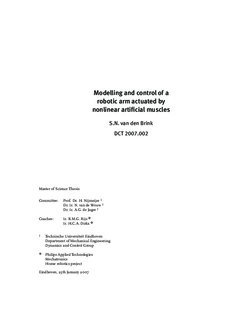
Modelling and control of a robotic arm actuated by nonlinear artificial PDF
Preview Modelling and control of a robotic arm actuated by nonlinear artificial
Modelling and control of a robotic arm actuated by nonlinear artificial muscles S.N. van den Brink DCT 2007.002 MasterofScienceThesis Committee: Prof. Dr. H.Nijmeijer‡ Dr. Ir. N.vandeWouw‡ Dr. Ir. A.G.deJager‡ Coaches: Ir. R.M.G.Rijsz Ir. H.C.A.Dirkxz ‡ TechnischeUniversiteitEindhoven DepartmentofMechanicalEngineering DynamicsandControlGroup z PhilipsAppliedTechnologies Mechatronics Homeroboticsproject Eindhoven,25thJanuary2007 Abstract Modernindustrialrobotsaredesignedaccordingtotheprincipaldesignrulestocon- struct light and stiff. These design rules are not suitable for robots to be used in a domesticenvironment. Industrialrobotsarestiffandstrongand,forthesereasons, dangeroustohumans. Toallowforrobotstobesafeinadomesticenvironment,they needtobecompliant. So, incaseadomesticrobotcomesincontactwithahuman, thisdoesnotleadtoinjuries. Several options are available to make robots compliant. One option is to use compliantactuators, forexampleaMcKibbenmuscle. Thisisapneumaticartificial musclewithgreatresemblancetoabiologicalmuscle. AMcKibbenmuscleconsists ofa15cmpieceofbicycletube,surroundedbyanylonbraidof20cm. Theendings ofthetubeandthebraidareconnectedusingafitting. Inflatingthemuscleyieldsa decreaseinmusclelengthandanincreaseindiameterandstiffness. To perform research on the applicability of McKibben muscles as robotic actuators, a robotic arm is constructed at Philips Applied Technologies in Eindhoven. It has two degrees of freedom and is actuated by four McKibben muscles. The research goals are, firstly, to construct a predictive model of the robotic arm including McKibben musclesand,secondly,toconstructcontrollersthatguaranteeaccuratemotioncontrol oftheroboticarm,usingmodelknowledgeontheroboticarmandthemuscles. ApredictivemodeloftheMcKibbenmuscleisproposed,whichtakesintoaccountthe changeinmuscleshapeaswellasinstiffness. Thismodelisusedinthetotalrobotic armmodel,alsoincludingthepneumaticsandtherigidbodydynamicsofthearm. Dedicatedexperimentsareperformedtoidentifytheparametersofthemusclemodel and the robotic arm model. Other experiments are used to validate whether the modelsgiveacorrectpredictionoftheexperimentalroboticarmbehavior. Itappears that the robotic arm behavior is predicted correctly within a limited pressure range. Themainmodelerrorisinthedescriptionofthemusclestiffness. Theknowledgegainedbytheexperimentsandthemodellingisusedtodefineacon- trolstrategy. Bydrivingthemusclesinpairs,theroboticarmisstabilizedcompletely usinglinearfeedbackcontrollers. Eachmusclepairrequirestwocontrollers: oneto control the robotic arm position and one to control the pressure in both muscles. ThestiffnessvariationasafunctionofthemusclelengthoftheMcKibbenmusclesis completelycompensatedforbyapplyinganotch-filterinthepositioncontroller. The controllersareimplementedonbothaone-andtwo-degree-of-freedomvariantofthe experimentalsystem. Closed-loopexperimentsshowtheeffectivenessofthecontrol strategy,wherethefeasiblebandwidthofthiscontrolledsystemis4Hz. Toimprovethepredictivecapacitiesoftheroboticarmmodel,futureresearchonthe forcebalanceinsideamuscleandthesubsequentstiffnessisrequiredandadvised. i ii Samenvatting Moderneindustriëlerobotszijnontworpenvolgenshetprincipeomlichtenstijfcon- strueren. Deze ontwerp principes zijn echter niet geschikt voor huiselijke robots. Industriëlerobotszijnstijfensterkenzijndaaromgevaarlijk; zestaanomdierede danookaltijdafgeschermdvanmensen. Omdetoepassingvanrobotsineenwoon- omgevingmogelijktemaken,zullendezecompliant(minderstijf)moetenzijnzodat zemeegevenalsertegenaanwordtgestoten. Ditomverwondingentevoorkomen. Erzijnverschillendemanierenomeenrobotcomplianttemaken. Eénmogelijkheid is om robots aan te drijven met actuatoren die niet stijf zijn, bijvoorbeeld een McKibbenspier. Ditiseenkunstmatigepneumatischespierdiequagedragergveel lijktopeenbiologischespier. EenMcKibbenspierbestaatuit15cmfietsbinnenband metdaaromheeneennylonnetjevan20cm. Deuiteindenvandebandenhetnetje zijnaanelkaarbevestigdmeteenafsluitdop. Doordespieropteblazenwordtdeze korter,dikkerenstijver. OmdetoepasbaarheidvanMcKibbenspierenalsrobotactuatorenteonderzoeken,is bijPhilipsAppliedTechnologiesinEindhoveneenrobotarmgebouwd. Dezeheefttwee graden van vrijheid en wordt aangedreven door vier McKibben spieren. De onder- zoeksdoelenzijn, teneerste, omeenvoorspellendmodelvanderobotarminclusief deMcKibbenspierenteontwerpenen,tentweede,ommetkennisvanderobotarm envandespieren,regelaarsteontwerpendiegecontroleerdebewegingenvandero- botarmgaranderen. EenmodelvoordeMcKibbenspierenisbedacht,datzoweldevormveranderingals de verandering in stijfheid beschrijft. Dit model is vervolgens gebruikt in het totale robotmodel,inclusiefpneumatiekendedynamicavanderobotarm. Met behulp van experimenten is het gedrag van de spieren en van de robot arm in kaartgebracht. Dezeexperimentenzijngebruiktomdeparametersinhetmodelaf te schatten en om te verifiëren of de modellen een realistische beschrijving geven van de werkelijkheid. Uit validatie experimenten blijkt dat het gedrag van de robot arm in een beperkt druk goed voorspeld wordt. De grootste model fout zit in het voorspellenvandestijfheidvandeMcKibbenspieren. Dekennis,verworvendoordemetingenenhetmodel,isgebruiktomeenregelstra- tegieteformuleren. Hetblijktdat,alsdespiereninparenwordenaangestuurd,het mogelijkisommetbehulpvaneenvoudiglineaireregelaarsderobotarmvolledigte stabiliseren. Voorelkpaarspierenzijntweeregelaarsnodig;éénvoordepositievan derobotarmenéénvoordedrukinbeidespieren. Essentieelinhetontwerpvande positie regelaar is een ”notch” filter, die de variatie in stijfheid van de spieren volle- diggecompenseerd.Ditisgetestopderobotarmvoorzoweleenconfiguratiemetéén iii alsvooreenconfiguratiemettweegradenvanvrijheid.Experimentenaanhetgere- geldesysteemtonendeeffectiviteitvandevoorgestelderegelstrategieaan,waarbij demaximalebandbreedte4Hzis. Omhetmodelvanderobotarmbetertelatenvoorspellen,isverderonderzoeknaar dekrachtbalansindespierenendedaaruitvolgendestijfheidnodigenaanbevolen. iv Preface This report describes the results of my graduation project at the Dynamics and ControlgroupoftheTechnischeUniversiteitEindhoven. Theprojectiscarriedout under authority of the Mechatronics department of Philips Applied Technologies inEindhoven. DuringmyassignmentIreceivedalotofhelpandsupportbymany people. HerewithIwouldliketoshowmygratitude. Inthefirstplace, IwouldliketothankmycoachesRobRijsandBartDirkxfrom PhilipsAppliedTechnologiesandNathanvandeWouwandHenkNijmeijerfrom TechnischeUniversiteitEindhovenfortheirsupport,inputandcriticalcomments duringmyresearch. Iappreciatethatverymuch. Inthesecondplace,butinvaluable,Iwouldliketothankthepeopleandstudents attheMechatronicsdepartmentofPhilipsAppliedTechnologiesfornumerousdis- cussions,pleasureandforshowingmethetruecapabilitiesofengineering. Finally,IliketoshowmygratitudetowardsmyparentsMarcelleandWim,fortheir greatsupportduringalmosttenyearsofstudying,andtomygirlfriendEsther,for herpatienceandcomfort. v vi Contents Abstract i Samenvatting iii Preface v Nomenclature xi 1 Introduction 1 1.1 Problemstatement 4 1.2 Reportoutline 6 2 Descriptionoftheroboticarmandthemuscles 7 2.1 Setupoftheroboticarm 7 2.2 Sensorsandcontrolplatform 8 2.3 Pneumaticsandthebinaryvalves 9 2.4 McKibbenmuscles 10 2.4.1 Construction 10 2.4.2 Workingprinciple 10 2.5 Contributionofthethesis 12 3 Physicalmodelling 15 3.1 Roboticarmmodel 15 3.2 Inputsignalsandthebinaryvalves 18 3.3 Pneumatics 21 3.3.1 Pressureandflowrelations 21 3.3.2 Splitter 24 3.3.3 Formulationofthepneumaticmodel 26 3.4 McKibbenmuscles 27 3.4.1 Braidkinematics 27 3.4.2 Musclevolume 28 3.4.3 Pressureinthemuscle 29 3.4.4 Nominalmusclelength 30 3.4.5 Forceexertedbythemuscle 31 3.4.6 Musclestiffnessanddamping 32 3.4.7 Formulationofthemusclemodel 33 vii 3.5 Equationsofmotionoftheroboticarm 34 3.5.1 Robotkinematics 34 3.5.2 Robotdynamics 36 3.6 Discussion 37 4 Identificationandmodelvalidation 39 4.1 Muscleidentification 39 4.2 Validationoftheequilibria 45 4.3 Roboticarmidentification 48 4.4 Validationofthelinearizedmodel 52 4.5 Timedomainmodelvalidation 55 4.6 Discussion 56 5 Feedbackcontroloftheroboticarm 59 5.1 Singlejointcontrolstrategy 59 5.2 Singlejointcontrol 62 5.2.1 Angularcontrollerdesign 63 5.2.2 Pressurecontrollerdesign 63 5.2.3 Performance 67 5.3 Dualjointcontrol 67 5.3.1 Dualjointcontrolstrategy 69 5.3.2 MIMOsystemidentification 70 5.3.3 Loopshapingofthecontroller 71 5.4 Feedbackcontrolversusreinforcementlearning 75 5.5 Discussion 78 6 Conclusionsandrecommendations 79 A Specificationsoftheroboticarmparts 83 A.1 Additionalphotosoftheroboticarm 83 A.2 Binaryvalves 86 A.3 FestoSDE1pressuresensor 88 A.4 NovotechnikSP2500potentiometer 89 A.5 Electricalschemeoftheswitchingboard 90 B McKibbenmusclesproperties 91 B.1 Advantagesanddisadvantages 91 B.2 LiteratureonMcKibbenmuscles 92 B.2.1 McKibbenmusclemodels 92 B.2.2 ControlstrategiesforsystemswithPAM’s 94 B.3 ExampleofaMcKibbenmuscleusedasactuator 95 B.4 ThetubeofaMcKibbenmuscle 97 C Pulsewidthmodulation 99 C.1 FormulationofthePWMalgorithm 101 C.2 Saturationfunction 103 viii
Description: